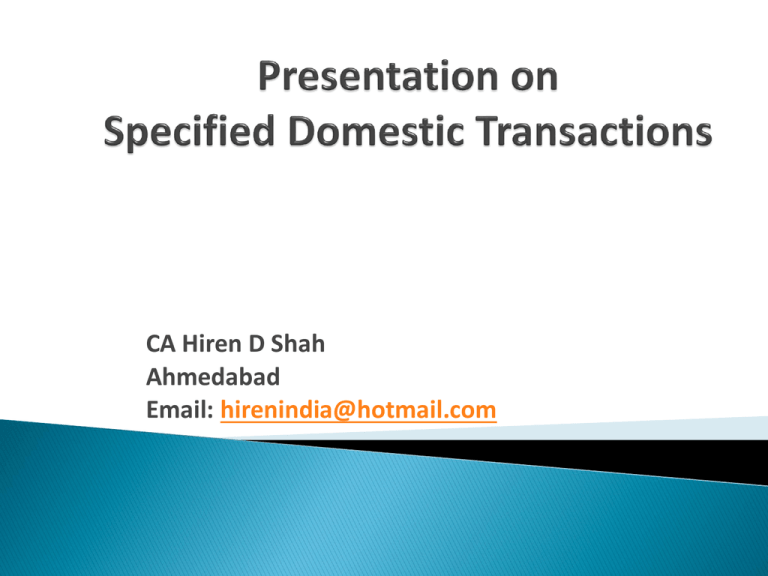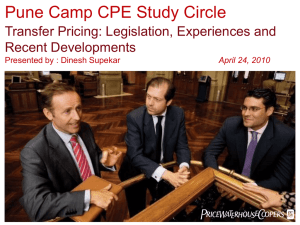Specified Domestic Transactions
advertisement

CA Hiren D Shah Ahmedabad Email: hirenindia@hotmail.com Transfer Pricing until now was applicable to Companies having cross border transactions with their Associated Enterprise Honoring the Supreme Court ruling in case of CIT vs M/s Glaxo Smithkline Asia (P) Limited expanded the ambit of transfer pricing to Specified Domestic Transactions w.e.f. 1st April,2013 Transfer Pricing (“TP”) was earlier limited to ‘International Transactions’ TP provision will now apply to ‘Specified Domestic Transactions’ ◦ Expenditure for which payment is made or to be made to domestic related parties ◦ Tax Holiday / Deductions claimed by the assessee Transfer of goods or services between various businesses of same assessee More than ordinary profits derived from transactions with closely connected persons TP provisions to apply if the aggregate of ‘Specified Domestic Transactions’ exceeds five crores Shift of focus from generic ‘Fair Market Value’ concept to ‘Arm’s Length Price’ ◦ Fair Market Value can established using basic market evidence ◦ Arm’s Length Price can be determined by use of five prescribed methods Advance Pricing Agreements NOT applicable to specified domestic transactions Assessing officer’s powers shifted to Transfer Pricing Officer (‘TPO’) In domestic transactions, the under invoicing of sales and over-invoicing of expenses ordinarily will be revenue neutral in nature except in two circumstances having tax arbitrage such as where one of the related entities is ◦ Loss making or ◦ Liable to pay tax at lower rate and the profits are shifted to such entity Intent of Indian Transfer Pricing (TP) Regulations Associated Enterprise (AE Co.) Indian Co. India (Tax @ 33%) Shifting of Losses Overseas (Tax at Lower rates, say 10%) Tax Savings for the group -> Indian Govt. loses Intent of Domestic TP-Domestic Tariff Area (DTA) Scenario 1 Scenario 2 Particulars Co.A Co.B Particulars Co.A Co.B Taxed in India @ 33% 33% Taxed in India @ 33% 33% Income from RP 100 - Income from RP 150 - Other Income 200 400 Other Income 200 400 Expense to RP - 100 Expense to RP - 150 Other Expenses 400 200 Other Expenses 400 200 Profit / Loss (100) 100 Profit / Loss (50) 50 - 33 Tax Total Tax for the Group 33 Tax Total Tax for the Group - 17 17 By shifting of expenses fro a loss making company to a profit making company, the group could reduce its tax liability by 16 for the current year, though the impact will be reversed in future years given carry forward of losses. To avoid such cases and even though there is no erosion of tax base, Domestic TP has been introduced. Intent of Domestic TP-DTA & Tax Holiday Unit Scenario 1 Particulars Scenario 2 Co.A Co.B Particulars Co.A Taxed in India @ 0% Income from RP Other Income 33% Taxed in India @ 0% 33% 150 - Income from RP 225 - 300 600 Other Income 300 600 Expense to RP - 150 Expense to RP - 225 Other Expenses 300 300 Other Expenses 300 300 Profit / Loss (150) 150 Profit / Loss 225 75 - 50 Tax Total Tax for the Group 50 Tax Total Tax for the Group Co.B - 25 25 By shifting of expenses from a tax holiday unit (Power) to a unit in the Domestic Tariff Area, the group could reduce its tax liability by 25. To avoid such cases, Domestic TP has been introduced. This is an anti-abuse provision brought to check the excessive tax holiday claims Generic framework of ‘More than ordinary profit’ was provided in law to compute the excessive tax holiday claims Various tribunal rulings in favor of taxpayers virtually made this clause redundant To plug the loophole, it is now proposed to compute more than ordinary profits through the ‘arm’s length price’ mechanism Impact/ Issues ◦ The assessee carrying on the eligible business will have to justify the ALP of the transactions between the eligible unit/ business and any other person with whom the assessee has close connection ◦ The term “Close Connection” under section 80IA(10) not defined ◦ Burden of the proving the “close connection” between the assessee and other party is on TPO ◦ Loss of tax holiday claim in excess of arm’s length profits ◦ No corresponding adjustment allowed for other party for adjustments made, if any, by the TPO for transactions falling under this category Scope – Domestic Transactions Tax holiday undertakings covering : • inter-unit transfer of goods and services • transactions with entities having close connection Expenditure incurred between related parties defined u/s 40A Any other transaction that may be specified Aggregate Transaction value exceeds Rs. 50 millions in a financial year (Applicable for FY 201213 Section Nature of Undertakings covered 80IA Undertakings engaged in • Developing, operating and maintaining, developing and operating and maintaining infrastructure facilities • Generation/ transmission or distribution of power • Reconstruction/ revival of power generating plants 80IB Undertakings located/ engaged in • Industrially backward districts as notified; • Scientific research & development • Refining of mineral oil/ commercial production of natural gas • Operating cold chain facility for agricultural produce • Processing, preservation and packing of meat/ meat products or poultry/ marine/ dairy products • Operating and maintaining a hospital of specified capacity 80IC Undertaking located in notified Centre/ Parks/ Areas in • Sikkim • Himachal Pradesh/ Uttaranchal • North- Eastern states 80ID Undertaking engaged in business of hotel/ convention centre in specified areas/ districts 10AA Undertakings having a Special Economic Zone unit Expenses Transactio n within Company • Expenses paid by domestic companies to related parties will be challenged • Corresponding adjustment not permitted for disallowed expenses; will lead to double taxation • Company with multiple units and claiming tax holiday will be questioned on inter unit transfers • Authorities will attempt to reduce profitability of exempted unit for reducing the quantum of deduction • Companies declaring ‘More than ordinary Profits’ for tax holiday units will loose excessive income-tax benefits Tax Holiday Shift of Approach Compliance • Approach will shift from generic ‘Fair Market Value’ concept to Arm’s Length pricing • Heavy Compliance burden of maintaining: • transfer pricing documentation and • reporting of transactions (Form 3CEB) • Assessment / audit by specialized cell of TPO Assessment “Arm’s length price” means a price which is applied or proposed to be applied in a transaction in uncontrolled conditions Arm’s Length price is determined using the Most Appropriate Method : Methods Comparability Comparable Uncontrolled Price Method ‘Price’ of the transactions Resale Price Method ‘Gross margin’ of company reselling products / services to unrelated parties Cost Plus Method ‘Gross margin’ of company selling manufactured products / services to related parties Profit Split Method ‘Splits profits’ between parties to transactions based on economic parameters Transactional Net Margin Method ‘Net Profit margin’ (Operating Profit) of ‘Tested Party’ If more than one comparable price is obtained using above methods, then the arm’s length price would be ‘Arithmetic Mean’ of comparable prices ◦ Deviation of plus / minus three percent is permitted from arm’s length price Domestic Transfer Pricing usher shift from generic ‘Fair Market Value’ concept to Arm’s Length Pricing Characteristic Fair Market Value Arm’s Length Pricing Definition The price which goods or services would have fetched or cost in the open market A price which is applied in a transaction in uncontrolled conditions Computation Mechanism No specific mechanism provided in law Most appropriate method out of five prescribed methods Transaction Value Any market pricing point can be treated as fair market value Arithmetic mean of comparable prices treated as arm’s length price Sample Size One comparable may be sufficient to establish fair market value Require bigger sample size for establishing arm’s length Deviation No deviation permitted from fair market value Deviation of plus / minus three percent is permitted Expenditure paid or to be paid to related parties will require to be at arm’s length Examples of related parties under section 40A(2)(b) Payer Receiver of Payment Individual • Relative of individual Company • Director of company or relative of the director AoP/ HUF • Member of AoP / HUF or relative of such member Any taxpayer • Payment to a person who has substantial interest • Payment to a director / partner / member / relatives of a person who has substantial interest • Payment to a company in which my parent (more than 20% holding) has substantial interest • Payment to a person whose director/ partner/ member has substantial interest • Payment to a director/ partner/ member/ relatives of a person whose director/ partner/ member has substantial interest • Payment to a person in which I have substantial interest • Payment to a person in which my director/ partner/ member/ relatives have substantial interest • Payment to any of my director/ partner/ member/ relatives Substantial Interest means beneficial ownership of shares with at least 20% voting right or beneficial entitlement of at least 20% of the profits Section 2(41) defines relative in relation to an individual to mean: ◦ ◦ ◦ ◦ ◦ Husband; Wife; Brother; Sister; or any lineal ascendant or descendant; Proviso inserted in section 40A(2)(i) to the effect that disallowance shall not be made if the specified domestic transactions are at arm’s length price Provisions applicable only to expenditure where payment is made or to be made ◦ Does this include capital expenditure? ◦ Does this include transactions without consideration? ◦ Excessive discounts not covered Wide coverage and goes beyond the related parties covered under AS-18 Whether Government approval u/s 295, 297 of the Companies Act would be relevant? Means an enterprise – ◦ (a). Which participates, directly or indirectly, or through one or more intermediaries, in the management or control or capital of the other enterprises; or ◦ (b). In respect of which one or more persons who participate, directly or indirectly, or through one or more intermediaries, in its management or control or capital, are the same person who participate, directly or indirectly, or through one or more intermediaries, in the management or control or capital of the other enterprise. Interest free Loans to group Companies Granting of Corporate Guarantees / Performance Guarantee by Parent Company to its Subsidiaries Intra-group purchase/sell/ service transactions Payment made to key personnel of the assesse e.g. Directors/CEO/CFO Payment made to key personnel of the group Companies Payment made to relatives of key personnel of the assesse/ group companies For Royalty payments it has held in the decision of Oracle India Pvt Ltd vs. ACIT, some weightage was attributed by the Delhi Bench of the ITAT to the earlier RBI norms governing remittance of royalties in the computation of ALP In SGS India Pvt Ltd vs. ACIT 292 ITR 93(Bom), it was held that some importance needs to be given in a case where the RBI had allowed the remittance of research and development expenditure considering its disallowance by the assessing officer. Similarly Can one rely on the remuneration guidelines under schedule XIII of the Companies Act to determine Director Remuneration at Arms’ length Price? If aggregate of International and Domestic transaction exceeds INR 50 million, Do we need to demonstrate ALP for Domestic transaction which is otherwise below INR 50 million? If aggregate of International and Domestic transaction exceeds INR 50 million, but the International Transactions are below INR 10 million, Do we need to maintain documents prescribe under Rule 10D? ( Reference Rule 10D(2) Would claim of Depreciate comes under the ambit of Domestic Transfer Pricing? Under which Form, report for Domestic transfer Pricing shall be given? [ Section 92BA refer Section 92E] [ Prescribed form u/s92E is Form 3CEB which refers to the report on International Transactions] Revised Form 3CEB shall be notified in order to cover Specific Domestic Transactions Section 92A [AE and Deemed AE] deals with directly or indirectly interested vis-à-vis Section 40A(2)(b) [Specified Domestic Related Party] deals with directly interested Entity Related Price Related Profile of Industry Transaction terms Profile of group Functional Analysis (functions, assets and risks) Profile of Indian entity Profile of AEs Economic Analysis (method selection, comparable benchmarking) Forecasts, budgets, estimates Transaction Related Agreements Invoices Pricing related correspondence (letters, e-mails, fax, etc.) Default Nature of penalty In case of a post-inquiry 100-300% of tax on the adjusted amount adjustment, there is deemed to be a concealment of income Failure to maintain documents 2% of the value of each international transaction or specified domestic transaction Failure to furnish documents 2% of the value of each international transaction or specified domestic transaction Failure to report a transaction in accountants report 2% of the value of each international transaction or specified domestic transaction Maintaining or furnishing incorrect information or documents 2% of the value of each international transaction or specified domestic transaction However, penalty for concealment of income shall not be levied if the taxpayer demonstrates that price charged or paid has been determined in ‘good faith’ and with ‘due diligence’









